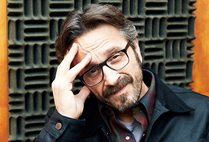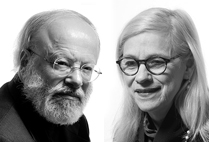The strange thing is, the International Place security isn’t lifting a finger to stop the two women splattering paint on the sidewalk. In fact, blacksuited staff helped rope off space for the graffiti-makers, chatting amiably with the wheelchair-bound Santa Claus look-alike in a blue fleece coat, a man who in some circles is just as iconic as St. Nick.
“Hey guys, look what we’re doing. We’re painting a cornucopia on the ground,” Robert Guillemin (CFA’62,’67), better known as Sidewalk Sam, says with boyish gusto to Financial District passersby. His wife, Tina, and artist friend Ying Zhang (CFA’11) diligently daub autumnal browns, yellows, and creams into the shape of a horn overflowing with acorns, squash, and onions. Sidewalk (even Tina calls him that) leans from his chair to brush some tomatoes into the painting, but mostly he supervises and banters with pedestrians.
For more than 40 years, Sidewalk Sam has used Boston’s (and occasionally other cities’) sidewalks, streets, and plazas as canvases for paint or chalk, sometimes recruiting passersby as collaborators. There’s no count of his asphalt and concrete creations—“Probably thousands; I wouldn’t even guess,” says Tina—but they’ve ranged from reproductions of famous masterpieces to a simple vine he coaxed BU students into drawing at the 2010 Comm Ave Fair. The oddity of his medium made him a media magnet long before then, and long before the wheelchair (the result of a 1994 fall off his roof ). International Place invites him to decorate its sidewalk every year; he once painted Mount Rushmore with the faces of Mayor Thomas Menino (Hon.’01) and other local notables.
Sidewalk gives his cornucopia a one- to two-month lifespan before it vanishes under the wear and tear of the elements and human foot traffic. That perishability doesn’t faze him. He likens his art to a pleasant summer’s day chat on the veranda of his Newton house. “It’s going to end,” he says. “And you and I will disappear and only have a memory of our morning. I think knowing that makes this more precious.”
In recent years Guillemin has become involved with social concerns. In 2007, following a spate of teen violence, he wanted to create a platform for the majority of kids who were trying to enjoy normal childhoods. Backed by churches and youth organizations, Guillemin’s Paint for Peace sponsored public drawings of peace doves in various Boston neighborhoods, “so that when somebody gets off the bus at night, coming home from work, they see that a happy child made a statement about peace.” In 2011, Guillemin found himself empathizing with the Occupy movement’s populism, but put off by what he considered its exclusionary demonizing of businesspeople. He drew hundreds of foot-by-foot squares in Copley Square and invited passers-by to “occupy your square” by writing something nice about humanity, their family, whatever. He had lots of takers.
So many, in fact, that the project had a fitting denouement for the pavement populist: he ran out of money. “The chalk was beginning to cost $300, $400, $500 a session.”













































Related Stories
855 Comm Ave Mural a Community Effort
BU Arts Initiative, CFA fund freshman’s proposal
Ready-Mixed Murals
Turning concrete mixer trucks into swirling, spiraling works of art
Bringing Whimsy to Bay State Road
Daria Lugina (CFA’19, CAS’19) transforms brownstone doors with revolving art project
Post Your Comment